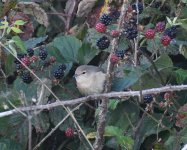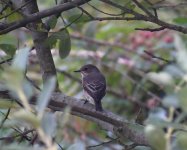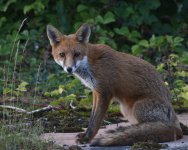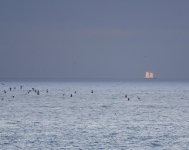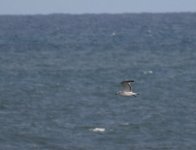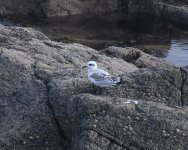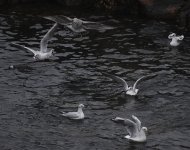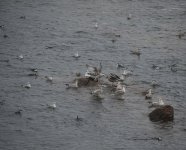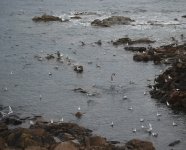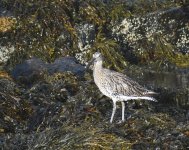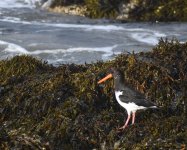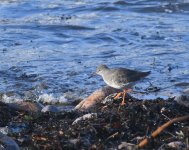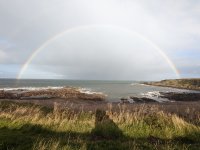-
Welcome to BirdForum, the internet's largest birding community with thousands of members from all over the world. The forums are dedicated to wild birds, birding, binoculars and equipment and all that goes with it.
Please register for an account to take part in the discussions in the forum, post your pictures in the gallery and more.
You are using an out of date browser. It may not display this or other websites correctly.
You should upgrade or use an alternative browser.
You should upgrade or use an alternative browser.
Birds fae Torry (5 Viewers)
- Thread starter Andrew Whitehouse
- Start date
More options
Who Replied?
It was murky and breezy today. I headed around the headland late in the afternoon. I didn't look too hard for migrants. A Wheatear was on the golf course. The sea was fairly busy, with large flocks of Kittiwakes feeding offshore. Among them was a juvenile Little Gull. Terns were more conspicuous than they have been for a while, with two Common Terns, three Sandwich Terns and six Arctic Terns. A Sooty Shearwater went north, as did a group of three light-bellied Brent Geese - my first of the autumn. Other birds moving included an Arctic Skua and nine Manx Shearwaters. Much the highlight was a breaching Humpback Whale, which appeared a couple of times but whose blow was visible more frequently. I guess this was the one Mark saw yesterday, so it's probably hanging around.
Below are a couple of migrant pictures from yesterday.
Below are a couple of migrant pictures from yesterday.
Attachments

It was quite a pleasant, sunny day in Torry and I was out for a fair while. I spent the morning around St Fittick's, hoping to see any migrants that might be lingering there. Good numbers of phylloscs were about but otherwise it was fairly quiet. Totals were six Willow Warblers, six Chiffchaffs, a Whitethroat and two Goldcrests (one of which was singing). I had brief views of a Water Rail from the concrete bridge - my first for a while. A Snipe was in the marsh, along with a few ovipositing Common Darters.
I headed around the headland late afternoon. Around seven Wheatears was a good total, as were the 18 Dunlin on the breakwater. Two Knot were with them, although there was no sign of Mark's patch mega Curlew Sandpiper from earlier. I did manage a bit of patch gold when I started seawatching, however. Fairly soon after starting, a Red-necked Grebe hurtled northwards - only my second ever here. Other birds moving included 33 Manx Shearwater, five Arctic Skuas, a Bonxie, an Arctic Tern, a Red-breasted Merganser and 18 Common Scoter.
I headed around the headland late afternoon. Around seven Wheatears was a good total, as were the 18 Dunlin on the breakwater. Two Knot were with them, although there was no sign of Mark's patch mega Curlew Sandpiper from earlier. I did manage a bit of patch gold when I started seawatching, however. Fairly soon after starting, a Red-necked Grebe hurtled northwards - only my second ever here. Other birds moving included 33 Manx Shearwater, five Arctic Skuas, a Bonxie, an Arctic Tern, a Red-breasted Merganser and 18 Common Scoter.

Things were relatively low key today, after a fairly busy few weeks. A Garden Warbler was along the north bank below the allotments but it was the only notable migrant, aside from two Wheatears. A Whimbrel went south and other waders included eight Knot and nine Dunlin. A Buzzard over Tullos Hill was my first for a while. Not much was happening offshore, although one Manx Shearwater and a Red-throated Diver went through.

I had a fairly quick look around the headland this evening. Of note was an adult Little Gull around the harbour mouth. Offshore, two Arctic Skuas were lingering and two Red-breasted Mergansers went north.

I had another evening walk around the headland in delightful, calm conditions. Two Willow Warblers were along Abbey Road and a couple of Wheatears were on the golf course. The breakwater held a good collection of waders including a Ruff and 11 Dunlin. Four Arctic Skuas were marauding offshore but the best bird was probably a Tufted Duck going north.
Attachments
Cucurrucucu
Cucurrucucu
A grey wagtail, ~8 curlew, 3 or 4 heron, a stonechat and then a sparrowhawk being chased by a crow over the golf course were about the only things of note this morning.
The fox was around too.
If anybody is interested in badgers, we still have two visiting every night sometimes as early as 9pm. Not sure their sett is or what route they take along Abbey Place to get to us. (They do love peanuts.)
The fox was around too.
If anybody is interested in badgers, we still have two visiting every night sometimes as early as 9pm. Not sure their sett is or what route they take along Abbey Place to get to us. (They do love peanuts.)

A look around the headland this evening in very fresh conditions produced one or two notable birds. A Bar-tailed Godwit was roosting on the middle pier and a Kestrel was over the golf course. Five Manx Shearwaters were offshore and 13 Common Scoters also went through. The latter were followed by a patch year-tick Velvet Scoter going south.

I had an interesting seawatch today from mid morning until early afternoon, although the rare seabirds that appeared elsewhere in eastern Scotland weren't in evidence. Lots of seabirds were going north, with Razorbills particularly numerous. A juvenile Little Gull was maybe the best bird. Also moving were a Bonxie, an Arctic Skua, 12 Manx Shearwaters, an Arctic Tern, four Sandwich Terns, a Common Scoter, 14 Wigeon, eight Teal and ten Red-throated Divers. Another diver that went north looked like it wasn't a Red-throated, but I'm not totally sure what it was.

Another interesting day today, with the wind easing a bit and going a bit more round to a straight northerly. I headed out to the foghorn and seawatched there for around three hours during the afternoon. Lots of birds were moving and there were again very large numbers of Razorbills going through. I decided to do some timed counts. At times they were going through at over 100 a minute but they slowed down later. From these counts, my estimate for the three hours was 11,580. If they were going through at the same rate throughout the day (and I suspect they probably were) that would be around 50,000!
Other birds were on the move. Three Sooty Shearwaters were perhaps the best of it but 25 Arctic Skuas, many of them quite close, was a decent count. No other skuas were seen though. Other totals were 176 Manx Shearwaters, four Puffins, 20 Wigeon, ten Teal, five Dunlin and three Red-throated Divers. Terns were still about with six Sandwich Terns, three Common Terns and 11 Arctic Terns. A juvenile Mediterranean Gull, my second of the autumn, was lingering offshore and showed nicely at times.
Not too much else was about but a Bar-tailed Godwit was again roosting on the middle pier.
Other birds were on the move. Three Sooty Shearwaters were perhaps the best of it but 25 Arctic Skuas, many of them quite close, was a decent count. No other skuas were seen though. Other totals were 176 Manx Shearwaters, four Puffins, 20 Wigeon, ten Teal, five Dunlin and three Red-throated Divers. Terns were still about with six Sandwich Terns, three Common Terns and 11 Arctic Terns. A juvenile Mediterranean Gull, my second of the autumn, was lingering offshore and showed nicely at times.
Not too much else was about but a Bar-tailed Godwit was again roosting on the middle pier.
Attachments

It was another seawatch heavy session around the headland this afternoon. The wind had dropped and was veering around into the southeast, which seemed promising. A good sign was a group of ten Barnacle Geese, flying very low over the sea from the north - my first of the autumn. The sea was busy with birds for the 1.5 hours I watched. Ten Sooty Shearwaters was a good total, with most fairly distant but one was very close. Also going through were 125 Manx Shearwaters, eight Arctic Skuas, a Puffin, 12 Wigeon, ten Teal, seven Common Scoter and three Red-throated Divers. I didn't count the Razorbills today but there were still a lot going through, particularly towards dusk. A juvenile Long-tailed Skua headed north at mid-distance, standing out as very slim as they usually do.

It was a pleasant but slightly chilly day in Torry today with a brisk NW wind. I had a good look around St Fittick's in the morning. It was mostly the usual suspects with at least six Chiffchaffs the only migrants. Six Snipe were in the marsh. I'd not seen any flocks of Pink-footed Geese this autumn but had a couple of groups going over today.
A walk round the headland in the afternoon was mainly quiet but I did see two Mediterranean Gulls. The first was an adult feeding out to sea in a large group of gulls. Then a much closer juvenile was found loafing on the rocks near the foghorn. There were lots of birds feeding offshore but very little was moving. I did pick out one Puffin though. The Bar-tailed Godwit was still around and a Common Sandpiper was along the north shore. I was surprised to see a Stock Dove whizzing about around the harbour.
A walk round the headland in the afternoon was mainly quiet but I did see two Mediterranean Gulls. The first was an adult feeding out to sea in a large group of gulls. Then a much closer juvenile was found loafing on the rocks near the foghorn. There were lots of birds feeding offshore but very little was moving. I did pick out one Puffin though. The Bar-tailed Godwit was still around and a Common Sandpiper was along the north shore. I was surprised to see a Stock Dove whizzing about around the harbour.
Attachments

A generally pleasant day today, although some late rain brought things to an early conclusion. I looked around St Fittick's again this morning. At least ten Chiffchaffs and three Goldcrests were among the tit flocks. Three Redpolls were flying about and there were four Snipe in the marsh. 170 Pink-footed Geese went over and a Speckled Wood was good to see. The highlight was a Great Spotted Woodpecker, my first of the year, which called and showed briefly near the railway embankment.
The headland in the afternoon was reasonably lively. Waders included the Bar-tailed Godwit and seven Dunlin. An amazing feeding frenzy was going on in Greyhope Bay, right in among the rocks. A shoal of fish had obviously been stranded in the shallows by a falling tide and they were pursued by a huge gathering of gulls and auks. Sitting quietly on the rocks nearby was a lovely adult Little Gull. A short seawatch produced six Manx Shearwaters and an Arctic Skuas. Large numbers of auks, particularly Razorbills, were again moving.
One landmark to note is I've now seen 107 species in the area this month - my highest ever total in a calendar month.
The headland in the afternoon was reasonably lively. Waders included the Bar-tailed Godwit and seven Dunlin. An amazing feeding frenzy was going on in Greyhope Bay, right in among the rocks. A shoal of fish had obviously been stranded in the shallows by a falling tide and they were pursued by a huge gathering of gulls and auks. Sitting quietly on the rocks nearby was a lovely adult Little Gull. A short seawatch produced six Manx Shearwaters and an Arctic Skuas. Large numbers of auks, particularly Razorbills, were again moving.
One landmark to note is I've now seen 107 species in the area this month - my highest ever total in a calendar month.
Attachments

Cold and quite windy here today and not many birds were around compared to recent days. A couple of Manx Shearwaters were blowing about offshore. The light on the waders was good along the north shore and there was an excellent rainbow over Greyhope Bay.
Attachments
Cucurrucucu
Cucurrucucu
Not found much this week for me. Did see bait ball on the 24th just inside the breakwater. Need an expert eye to see if there were anything interesting in the maelstrom.
Apart from a sparrowhawk over St F's two days running (the second time being mobbed by 13 magpies and 6 crows), I've seen almost nothing.
But a week ago I found myself in the middle of a band of birds doing the rounds of the trees below the water treatment plant. Nothing out of the ordinary but two goldcrests came close enough to see them clearly. Looks as though at least one of them has a ring.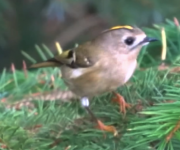
Apart from a sparrowhawk over St F's two days running (the second time being mobbed by 13 magpies and 6 crows), I've seen almost nothing.
But a week ago I found myself in the middle of a band of birds doing the rounds of the trees below the water treatment plant. Nothing out of the ordinary but two goldcrests came close enough to see them clearly. Looks as though at least one of them has a ring.


It was rather a fine day by recent standards today. I managed to get out around the headland for the final few hours of daylight. I looked for migrants for a bit to no avail. Reasonable numbers of waders included 15 Sanderling, 15 Dunlin and the Bar-tailed Godwit.
I suspected seawatching might offer the best prospects and so it proved. I only had time for 1.5 hours but it was probably one of my best ever seawatches here, aided by light southeasterlies and good visibility and light. It's hard to say what the highlight was but perhaps the best birds from my point of view were three Pomarine Skuas. The first was a fairly distant adult with full spoons - perhaps an intermediate bird. The others were much closer and were a brilliant adult accompanied by a very dark and plump looking juvenile. A dark juvenile Long-tailed Skua also went north at medium distance. My fifth Balearic Shearwater of the autumn was also the best view I've had of one here. It was in excellent light, at fairly close range and was accompanied by a couple of Manx Shearwaters for comparison. It was a paler bird than most I've seen here but still smoky brown on the underparts.
Other birds moving included two Great Skuas, four Arctic Skuas, four Sooty Shearwaters, a Puffin, two Fulmars, five Common Scoters, two Red-throated Divers and an Arctic Tern. Manx Shearwaters totalled 98 and there was a very substantial movement of Kittiwakes and Razorbills. I think this is the first seawatch I've ever done here that produced four species of skua.
I was surprised to see a bat, probably a Pipistrelle sp., along Victoria Road at dusk.
I suspected seawatching might offer the best prospects and so it proved. I only had time for 1.5 hours but it was probably one of my best ever seawatches here, aided by light southeasterlies and good visibility and light. It's hard to say what the highlight was but perhaps the best birds from my point of view were three Pomarine Skuas. The first was a fairly distant adult with full spoons - perhaps an intermediate bird. The others were much closer and were a brilliant adult accompanied by a very dark and plump looking juvenile. A dark juvenile Long-tailed Skua also went north at medium distance. My fifth Balearic Shearwater of the autumn was also the best view I've had of one here. It was in excellent light, at fairly close range and was accompanied by a couple of Manx Shearwaters for comparison. It was a paler bird than most I've seen here but still smoky brown on the underparts.
Other birds moving included two Great Skuas, four Arctic Skuas, four Sooty Shearwaters, a Puffin, two Fulmars, five Common Scoters, two Red-throated Divers and an Arctic Tern. Manx Shearwaters totalled 98 and there was a very substantial movement of Kittiwakes and Razorbills. I think this is the first seawatch I've ever done here that produced four species of skua.
I was surprised to see a bat, probably a Pipistrelle sp., along Victoria Road at dusk.
Cucurrucucu
Cucurrucucu
Fabulous list!Pomarine Skuas, Long-tailed Skua, Balearic Shearwater, Great Skuas, Arctic Skuas,Sooty Shearwaters, Puffin, Fulmars, Common Scoters, Red-throated Divers, Arctic Tern, Manx Shearwaters
Can they be seen/recognised with the naked eye or do you need bins/long lens?
We hope we have a bat sleeping in the bat box in our birch tree but haven't seen it in a while.

Thanks! Pretty much everything is seen and IDed with a scope, often at high zoom (50-60x) if they're further away. I would say most of those birds were between 800 and 1500 metres out. You can certainly see a fair amount with binoculars but it can be hard to ID anything except the obvious things like Gannet.Fabulous list!
Can they be seen/recognised with the naked eye or do you need bins/long lens?
We hope we have a bat sleeping in the bat box in our birch tree but haven't seen it in a while.

A bright and breezy day today around the headland. Mark and I ran an SOC meeting on 'Finding rare birds', which perhaps inevitably meant that we didn't find any. Something that was a rare occurrence around the Battery was a remarkable passage of Tree Sparrows. I reckoned at least 150 went through in various groups, although there were probably quite a lot more than that. Other stuff around there included a Redpoll, a Goldcrest and a Song Thrush. We did manage to find a Lesser Whitethroat along the north bank below the allotments but that was about the best of the migrants.
Otherwise, things were fairly quiet. Three Wigeon and an Arctic Skua went south.
Otherwise, things were fairly quiet. Three Wigeon and an Arctic Skua went south.
Users who are viewing this thread
Total: 6 (members: 0, guests: 6)




